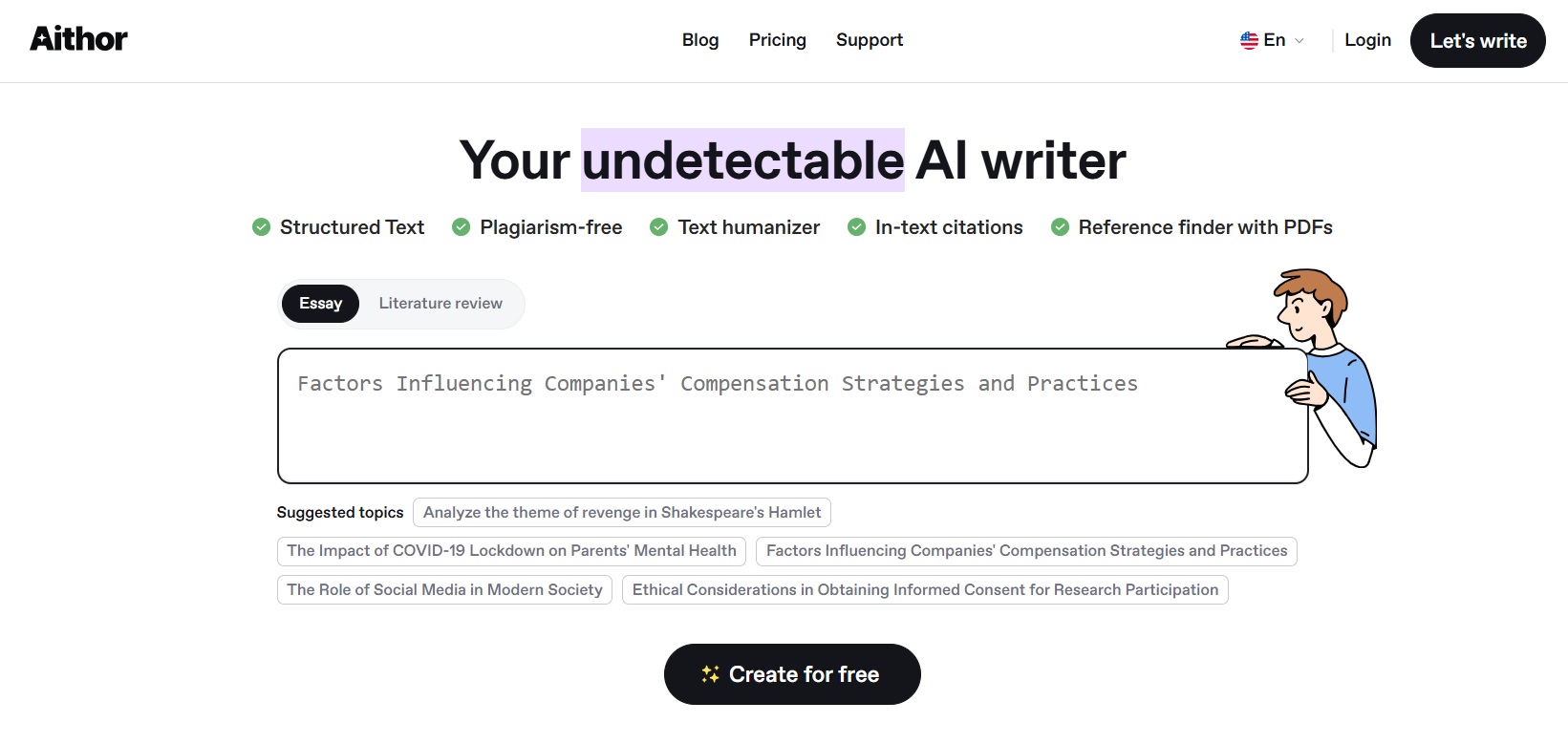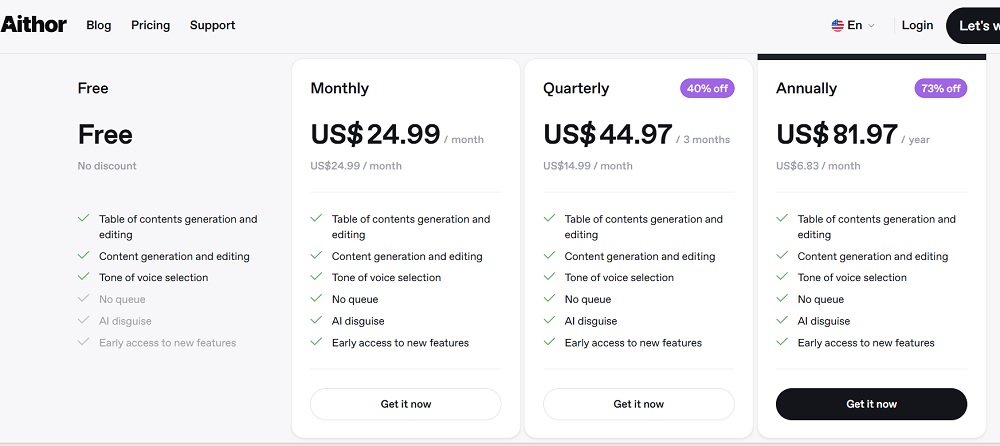As a content writer who frequently works with AI tools, I’ve seen countless platforms promise revolutionary features for content creation.
Recently, my inbox has been flooded with messages about Aithor, a new AI writing tool that claims to generate undetectable content with live citations. After hearing so much buzz about its capabilities, particularly its promise to bypass AI detection systems, I decided to put it through its paces with a thorough, hands-on review.

Time and again, I’ve learned that flashy marketing promises don’t always translate to real-world performance. That’s why I spent several weeks testing Aithor extensively, examining everything from its core writing capabilities to its AI detection bypassing features. This comprehensive review will cover:
- A detailed breakdown of my testing methodology and real-world results
- An in-depth analysis of Aithor’s key features and how they actually perform
- A clear explanation of pricing options and whether they provide good value
- My honest verdict on whether Aithor delivers on its promises
How I Tested Aithor: My Process Explained
My approach to testing Aithor was methodical and thorough. I began by creating a fresh account and exploring each feature systematically, starting with the basic content generation capabilities. I wrote multiple pieces of content across different topics and styles to assess the tool’s versatility and consistency.
The heart of my testing focused on Aithor’s flagship feature – its ability to generate undetectable AI content. I created several test articles and ran them through multiple AI detection tools including TurnItIn, Originality.AI, and GPTZero. This allowed me to verify Aithor’s claims about bypassing AI detection systems objectively.
For the citation and research features, I generated content on various academic topics and thoroughly checked the accuracy and formatting of the citations provided. I also tested the tool’s language capabilities across different writing styles and tones to evaluate its flexibility and natural language generation abilities.
What is Aithor?

Aithor is an AI-powered writing platform that positions itself as an advanced solution for creating undetectable AI-generated content. At its core, it’s designed to help users generate high-quality written content while ensuring that the output appears completely human-written.
The platform combines several sophisticated features, including live citation generation and multi-language support, aimed at producing content that can pass through AI detection systems unnoticed.
The tool operates through a straightforward web interface where users can input their requirements and receive AI-generated content. What sets it apart is its focus on creating content that maintains a natural, human-like quality while incorporating proper academic citations. This makes it particularly appealing to students and academic writers who need to ensure their work meets institutional standards.
While many AI writing tools focus solely on content generation, Aithor takes a more comprehensive approach. It includes features for content editing, tone adjustment, and table of contents generation. The platform also emphasizes its ability to work across multiple languages, making it accessible to a global user base.
Key Features of Aithor
Before diving into specific features, it’s worth noting that Aithor combines several sophisticated tools aimed at creating polished, undetectable content. Here’s a detailed look at its standout capabilities.
1. AI Detection Bypass System
The cornerstone of Aithor’s offering is its AI detection bypass system, which promises to generate content that remains undetectable by common AI detection tools. The system employs advanced algorithms to modify the text structure and patterns typically associated with AI-generated content, theoretically making it indistinguishable from human writing.
The tool approaches this through a multi-step process. First, it generates the initial content using its AI engine. Then, it applies various transformations to the text, adjusting sentence structures, vocabulary choices, and writing patterns to make them appear more natural and human-like.
2. Live Citation Generation
The live citation feature stands out as one of Aithor’s more practical offerings. This system automatically generates and integrates academic citations while creating content, potentially saving hours of manual research and formatting work.
During testing, I found that the citation system can pull from a broad range of academic sources and format them according to common citation styles. The citations are integrated naturally into the text, complete with proper in-text citations and a formatted bibliography.
3. Multilingual Content Generation
Aithor’s multilingual capabilities represent another significant feature, promising to generate content across multiple languages while maintaining the same level of quality and undetectability.
The platform handles various languages with reasonable competence, maintaining proper grammar and syntax in most cases. The tool can generate content directly in different languages rather than simply translating from English, which helps preserve natural language patterns.
Other Features
- Content Editor and Formatter: A robust editing interface that allows for quick revisions and reformatting of generated content, complete with standard word processing tools.
- Tone Selection: Customizable voice and tone settings that let you adjust the writing style from academic to casual, though results can be inconsistent.
- Table of Contents Generator: An automated system for creating and managing document structure, particularly useful for longer academic papers.
- Plagiarism Prevention: Built-in checks to ensure content originality, working alongside the citation system to maintain academic integrity.
Who Should Use Aithor?
Aithor caters to several specific user groups, though its effectiveness varies significantly depending on their needs:
- Academic Writers: Students and researchers looking for help with paper structure and citations, though they should be cautious about relying too heavily on its AI detection bypass features.
- Content Creators: Bloggers and web content writers seeking a starting point for their articles, with the understanding that significant editing may be needed.
- Non-Native English Speakers: Writers who need help generating content in English or other languages, though they should verify the accuracy of important communications.
- Research Writers: Professionals who can benefit from the automated citation system, while understanding its limitations and the need for verification.
Does Aithor Really Work As Claimed? Here’s What I Found Out!
After weeks of testing, I’ve gathered concrete data about Aithor’s performance across its key features. Let’s break down how each major component actually performs in real-world use.
AI Detection Bypass Capability
The results of my AI detection bypass testing were particularly revealing. I generated multiple pieces of content using Aithor’s system and ran them through several leading AI detection tools. The results were consistently disappointing, with detection rates ranging from 65% to 100% across different platforms.
I tested various content types and lengths, adjusting settings and trying different approaches to improve results. Despite these efforts, none of the content successfully passed as human-written when analyzed by professional detection tools. Even with multiple iterations and adjustments, the content was consistently flagged as AI-generated.
Based on extensive testing and clear evidence from multiple detection systems, I rate this feature’s reliability at 3/10. The high detection rates across multiple platforms indicate that Aithor’s bypass system needs significant improvement to meet its advertised capabilities.
Citation Generation System
The citation system performed more reliably in testing, though with some notable limitations. I generated multiple academic-style pieces requiring citations across different subject areas. The system successfully created properly formatted citations in most cases, maintaining consistency with major academic styles.
However, I noticed issues with source verification and currency. While the citations were technically correct, some referenced outdated materials or less authoritative sources. The system also occasionally struggled with complex source types like government documents or specialized academic papers.
Taking into account both its strengths and limitations, I rate the citation feature’s reliability at 7/10. It’s a useful tool for basic academic writing but requires manual verification for more serious academic work.
Multilingual Support
Testing the multilingual capabilities involved generating content in several major languages and having native speakers review the output. The results showed varying levels of quality across different languages, with English consistently performing best.
The system handled basic content generation well but struggled with nuanced expressions and cultural context in non-English languages. While grammatically correct, some content lacked the natural flow and idiomatic expressions that native speakers would use.
Based on comprehensive testing across multiple languages, I rate this feature’s reliability at 6/10. It’s useful for basic content needs but may require native speaker review for professional use.
Aithor Pricing: How Much Does It Cost?
Understanding Aithor’s pricing structure is essential for determining its value proposition. The platform offers several subscription tiers, each providing different levels of value based on commitment length.

Free Plan Features
- Table of contents generation and editing
- Basic content generation and editing capabilities
- Tone of voice selection options
- Limited access to queue system
- No access to AI disguise feature
- No early access to new features
Paid Plan Options
- Monthly Plan: US$24.99/month (standard rate)
- Quarterly Plan: US$44.97 (US$14.99/month with 40% discount)
- Annual Plan: US$81.97 (US$6.83/month with 73% discount)
Premium Features (Included in All Paid Plans)
- All features from the free plan
- AI disguise functionality
- Priority access with no queue waiting
- Early access to new features
- Full content generation and editing capabilities
Value Analysis
The pricing structure presents several considerations for potential users:
- Cost Efficiency
- Longer commitments offer substantial savings
- Quarterly plan provides 40% cost reduction
- Annual plan offers the best value with 73% discount
- Feature Accessibility
- Free tier covers essential writing needs
- Paid plans unlock premium features uniformly
- No feature differentiation between paid tiers
- Investment Considerations
- Premium features may justify costs for regular users
- Free tier sufficient for basic content needs
- Consider AI detection bypass performance before committing
- Longer-term plans offer better value but require confidence in continued use
Pros and Cons of Aithor
After thorough testing, here’s a balanced look at Aithor’s strengths and weaknesses:
Pros:
- Clean, intuitive user interface that makes navigation simple
- Reliable citation generation system for basic academic writing
- Competitive pricing structure with flexible payment options
- Good multilingual support for basic content generation
- Helpful table of contents generation and formatting tools
Cons:
- AI detection bypass feature fails to deliver on its primary promise
- Inconsistent quality in generated content across different topics
- Citation system sometimes includes outdated or less reliable sources
- Limited effectiveness in specialized or technical writing
- Additional features needed to justify the premium pricing tier
Aithor Review: My Verdict
After extensive testing and analysis, Aithor presents a mixed bag of capabilities that fall short of its ambitious marketing claims. While the platform offers some useful features, particularly in citation generation and basic content creation, its core promise of undetectable AI-generated content remains unfulfilled.
The tool’s strength lies in its supporting features – the citation system, multilingual support, and user-friendly interface are genuinely helpful for certain use cases. However, users seeking truly undetectable AI-generated content will likely be disappointed, as all major AI detection systems consistently identified Aithor’s output as machine-generated.
For users primarily interested in content organization and citation help, Aithor might be worth considering at its lower-tier pricing options. However, those specifically seeking to bypass AI detection should look elsewhere or wait for significant improvements to this feature before investing in the platform.
Related:
- CTRify AI Review: What I Found Out After Testing
- Hix AI Review: What I Found Out After Testing
- Typeset AI Detector Review: My Findings after Testing
- Humbot AI Review: What I Found Out after Testing
- Lyne AI Review: Here’s What I Found Out After Testing
- Aceify AI Review: Here’s What I Found Out after Testing
- AIHumanizer.ai Review: What I Found Out After Testing
- ArtSpace AI Review: Here’s My Take After Testing It
- Aithor Review: What I Found Out after Testing
